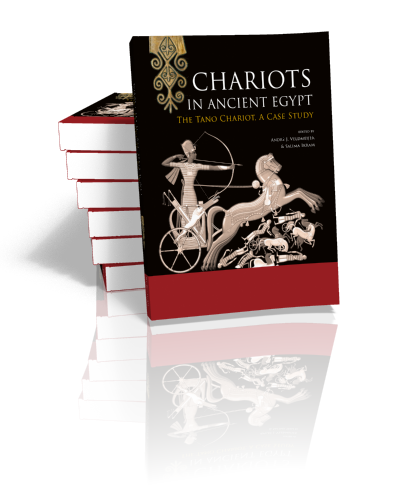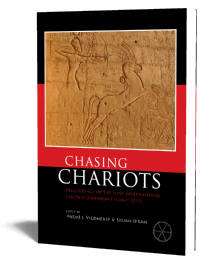Chariots in Ancient Egypt
The Tano Chariot, A Case Study
Edited by André J. Veldmeijer & Salima Ikram, with contributions by Ole Herslund, Lisa Sabbahy & Lucy Skinner | 2018

Chariots in Ancient Egypt
The Tano Chariot, A Case Study
Edited by André J. Veldmeijer & Salima Ikram, with contributions by Ole Herslund, Lisa Sabbahy & Lucy Skinner | 2018
Paperback ISBN: 9789088904660 | Hardback ISBN: 9789088904677 | Imprint: Sidestone Press | Format: 210x280mm | 590 pp. | Language: English | >350 illus. (fc) | Keywords: archaeology, chariots, leather, weaponry, Tutankhamun, Tano, Egyptian Museum Cairo, Ancient Egypt, egyptology | download cover
Read online or downloaded 6467 times
-
Digital & Online access
This is a full Open Access publication, click below to buy in print, browse, or download for free.
-
Buy via Sidestone (EU & UK)
-
Buy via our Distributors (WORLD)
For non-EU or UK destinations you can buy our books via our international distributors. Although prices may vary this will ensure speedy delivery and reduction in shipping costs or import tax. But you can also order with us directly via the module above.
UK international distributor
USA international distributor
-
Bookinfo
Paperback ISBN: 9789088904660 | Hardback ISBN: 9789088904677 | Imprint: Sidestone Press | Format: 210x280mm | 590 pp. | Language: English | >350 illus. (fc) | Keywords: archaeology, chariots, leather, weaponry, Tutankhamun, Tano, Egyptian Museum Cairo, Ancient Egypt, egyptology | download cover
Read online or downloaded 6467 times

We will plant a tree for each order containing a paperback or hardback book via OneTreePlanted.org.
Chariots, the racing cars of the ancient world, first appeared in Egypt about 1600 BC, and quickly became not only the preferred mode of transport for royalty and the elite, but also revolutionised military tactics and warfare. Remains of chariots have been found in Egyptian tombs –Tutankhamun’s tomb contained six chariots, which tripled the number of ancient Egyptian chariots known before the discovery of his tomb. However, none of the chariots was complete, as all lacked their leather casings, which were only known from images on tomb and temple walls.
In 2008, the Ancient Egyptian Leatherwork Project (AELP) working in the Egyptian Museum in Cairo, found a cache of several trays of red and green leather containing some 60 large leather fragments. Some of these had been noted before, but the find had been largely ignored and buried in the depths of the museum. This remarkable object entered the museum in 1932, a purchase from the Tano family, reputable dealers at that time, hence the nick-name ‘Tano Chariot’.
The Tano leather all came from a single chariot, including portions of the bow-case, the body’s casing and the horse housing. The leather is elaborately decorated in appliquéd green and red or beige leather. Parallels for some of these fragments are found in the Egyptian Museum in Cairo, the Metropolitan Museum of Art in New York, and the Ägyptisches Museum und Papyrussammlung in Berlin, many of which, until their appearance in this volume, are unpublished. This includes the chariot leather from the tombs of Amenhotep II, III, Tutmose IV and Tutankhamun.
This book presents the Tano material with fully illustrated, detailed descriptions. Chariot related texts and technological analyses – together with detailed comparisons with other chariots and associated leather remains – help provide possible dates for it. The find is put into context with chapters on relevant hieroglyphic texts, and a study of representations of chariots that help identify the various parts, and highlight the role of the chariot in Egyptian religion, propaganda, and culture.
The Tano Chariot leather, despite being unprovenanced, is a unique find, which reveals a great deal about ancient Egyptian leatherwork technologies, warfare, weapons, and chariotry.
Analysis
1 Introduction
2 Identification of Parts
3 Chariot Leatherwork Technology
4 Fitting the Pieces
5 Chariots of the New Kingdom: Context of Use and Iconography
6 Chariots in Texts, Writing and Language of New Kingdom Egypt
7 Changes over Time
8 Discussion
Catalogue
Tomb of Amenhotep II
Tomb of Tutmose IV
Amenhotep III
Tano
Main Casing
Siding Fill
Suspension Straps
Nave Hoops
Bow-Case
Harness
Unidentified
Salima Ikram
Salima Ikram is Distinguished University Professor of Egyptology at the American University in Cairo, and has excavated extensively in Egypt as well as in Turkey. She has directed the Animal Mummy Project, the Amenmesse Project (KV10/KV63), the North Kharga Oasis Darb Ain Amur Project, and headed the archaeozoology team at Kinet Hoyuk in Turkey.

Dr. André J. Veldmeijer
André J. Veldmeijer (Visiting Research Scholar American University in Cairo) studied archaeology at Leiden University and received his PhD in Vertebrate Palaeontology from Utrecht University in 2006. He has worked in Egypt since 1995 as a leather, footwear and cordage specialist in various research projects.
Lucy Skinner MSc
Lucy Skinner has an MSc in Conservation for Museums and Archaeology from University College London. She has worked as a museum conservator in the UK and as an independent archaeological conservator and organic materials specialist on various sites all over the world as well as for numerous projects in Egypt.
Prof. dr. Lisa Sabbahy
Lisa Sabbahy studied at Bryn Mawr College, University of California at Berkeley, and the University of Toronto. She is Assistant Professor of Egyptology at the American University in Cairo, and Program Director of the MA in Egyptology and Coptology.
Dr. Ole Herslund
Ole Herslund is a doctor of Egyptology and Egyptian Archaeology trained at University of Copenhagen and University College London. He has worked as research fellow and external lecturer at the Department of Ancient Near Eastern Studies, Institute of Regional and Cross-Cultural Studies, University of Copenhagen, and works on a number of projects throughout Egypt.
Abstract:
Chariots, the racing cars of the ancient world, first appeared in Egypt about 1600 BC, and quickly became not only the preferred mode of transport for royalty and the elite, but also revolutionised military tactics and warfare. Remains of chariots have been found in Egyptian tombs –Tutankhamun’s tomb contained six chariots, which tripled the number of ancient Egyptian chariots known before the discovery of his tomb. However, none of the chariots was complete, as all lacked their leather casings, which were only known from images on tomb and temple walls.
In 2008, the Ancient Egyptian Leatherwork Project (AELP) working in the Egyptian Museum in Cairo, found a cache of several trays of red and green leather containing some 60 large leather fragments. Some of these had been noted before, but the find had been largely ignored and buried in the depths of the museum. This remarkable object entered the museum in 1932, a purchase from the Tano family, reputable dealers at that time, hence the nick-name ‘Tano Chariot’.
The Tano leather all came from a single chariot, including portions of the bow-case, the body’s casing and the horse housing. The leather is elaborately decorated in appliquéd green and red or beige leather. Parallels for some of these fragments are found in the Egyptian Museum in Cairo, the Metropolitan Museum of Art in New York, and the Ägyptisches Museum und Papyrussammlung in Berlin, many of which, until their appearance in this volume, are unpublished. This includes the chariot leather from the tombs of Amenhotep II, III, Tutmose IV and Tutankhamun.
This book presents the Tano material with fully illustrated, detailed descriptions. Chariot related texts and technological analyses – together with detailed comparisons with other chariots and associated leather remains – help provide possible dates for it. The find is put into context with chapters on relevant hieroglyphic texts, and a study of representations of chariots that help identify the various parts, and highlight the role of the chariot in Egyptian religion, propaganda, and culture.
The Tano Chariot leather, despite being unprovenanced, is a unique find, which reveals a great deal about ancient Egyptian leatherwork technologies, warfare, weapons, and chariotry.
Contents
Analysis
1 Introduction
2 Identification of Parts
3 Chariot Leatherwork Technology
4 Fitting the Pieces
5 Chariots of the New Kingdom: Context of Use and Iconography
6 Chariots in Texts, Writing and Language of New Kingdom Egypt
7 Changes over Time
8 Discussion
Catalogue
Tomb of Amenhotep II
Tomb of Tutmose IV
Amenhotep III
Tano
Main Casing
Siding Fill
Suspension Straps
Nave Hoops
Bow-Case
Harness
Unidentified
Salima Ikram
Salima Ikram is Distinguished University Professor of Egyptology at the American University in Cairo, and has excavated extensively in Egypt as well as in Turkey. She has directed the Animal Mummy Project, the Amenmesse Project (KV10/KV63), the North Kharga Oasis Darb Ain Amur Project, and headed the archaeozoology team at Kinet Hoyuk in Turkey.
Lucy Skinner MSc
Lucy Skinner has an MSc in Conservation for Museums and Archaeology from University College London. She has worked as a museum conservator in the UK and as an independent archaeological conservator and organic materials specialist on various sites all over the world as well as for numerous projects in Egypt.
Prof. dr. Lisa Sabbahy
Lisa Sabbahy studied at Bryn Mawr College, University of California at Berkeley, and the University of Toronto. She is Assistant Professor of Egyptology at the American University in Cairo, and Program Director of the MA in Egyptology and Coptology.
Dr. Ole Herslund
Ole Herslund is a doctor of Egyptology and Egyptian Archaeology trained at University of Copenhagen and University College London. He has worked as research fellow and external lecturer at the Department of Ancient Near Eastern Studies, Institute of Regional and Cross-Cultural Studies, University of Copenhagen, and works on a number of projects throughout Egypt.
-
Digital & Online access
This is a full Open Access publication, click below to buy in print, browse, or download for free.
-
Buy via Sidestone (EU & UK)
-
Buy via our Distributors (WORLD)
For non-EU or UK destinations you can buy our books via our international distributors. Although prices may vary this will ensure speedy delivery and reduction in shipping costs or import tax. But you can also order with us directly via the module above.
UK international distributor
USA international distributor
- Browse all books by subject
-
Search all books

We will plant a tree for each order containing a paperback or hardback book via OneTreePlanted.org.
You might also like:
© 2025 Sidestone Press KvK nr. 28114891 Privacy policy Sidestone Newsletter Terms and Conditions (Dutch)








